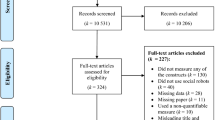Abstract
Robots that can communicate with people are one of the goals reached by the technology developed for automation in work life. Experts aim to improve the communication skills of these robots further in the near future. Besides, various studies emphasize that people may interact with robots in a similar way as they interact with other people. In line of this idea, this study examines the possible causal chain in which the social anxiety affects the robot anxiety which in turn affects the attitude toward interacting with robots. Data obtained from university students were analyzed in a simple and parallel mediation model. The results showed that robot anxiety and in particular two of its sub-dimensions mediate the relationship between social anxiety and negative attitudes toward interaction with robots. Researchers should carry out new studies about the common structural characteristics of the anxiety felt by people due to interacting with humans and robots.


Similar content being viewed by others
References
Achim N, Al Kassim A (2015) Computer usage: the impact of computer anxiety and computer self-efficacy. Procedia Soc Behav Sci 172:701–708
Aggarwal P, McGill AL (2007) Is that car smiling at me? Schema congruity as a basis for evaluating anthropomorphized products. J Consum Res 34(4):468–479
Alaiad A, Zhou L (2013) Patients’ behavioral intention toward using healthcare robots. In: Proceedings of the 19th Americas Conference on Information Systems (pp. 1–11).
Albarracin D, Shavitt S (2018) Attitudes and attitude change. Annu Rev Psychol 69:299–327
al-Jazari Ibn al-Razzaz (1974) The Book of Knowledge of Ingenious Mechanical Devices (Kitab fi ma ‘rifat al-hiyal al-handasiyya). Trans Donald Hill. Dordrecht Publishing Company, Dordrecht
Bartneck C, Nomura T, Kanda T, Suzuki T, Kato K (2005) Cultural differences in attitudes towards robots. Paper presented at the Proceedings Symposium on robot companions (SSAISB 2005 convention).
Bartneck C, Van Der Hoek M, Mubin O, Al Mahmud A (2007) “Daisy, daisy, give me your answer do!” switching off a robot. In: 2007 2nd ACM/IEEE international conference on human-robot interaction (HRI), Arlington, VA, USA, 9–11 March 2007. IEEE
Bartneck C, Bleeker T, Bun J, Fens P, Riet L (2010) The influence of robot anthropomorphism on the feelings of embarrassment when interacting with robots, Paladyn. J Behav Robot 1(2):109–115
Boyer P (2003) Religious thought and behaviour as by-products of brain function. Trends Cogn Sci 7(3):119–124
Coşkun H (2009) Etkileşim kaygısı ölçeği: Geçerlik ve güvenirlik çalışması. Türk Psikoloji Yazıları 12(23):41–49
Dario P, Guglielmelli E, Laschi C (2001) Humanoids and personal robots: design and experiments. J Robot Syst 18(12):673–690
de Graaf MMA (2016) An ethical evaluation of human-robot relationships. Int J Soc Robot 8(4):589–598
Erebak S, Turgut T (2018) Negative attitudes toward robots scale: validity and reliability of Turkish version. Toros Üniversitesi İİSBF Sosyal Bilimler Dergisi 5(9):407–418 http://dergipark.gov.tr/iisbf/issue/41627/486895
Erebak S, Turgut T (2019) Adaptation of the robot anxiety scale into Turkish. J Soc Sci Mus Alparslan Univ 7(5):9–13
Gates B (2007) A robot in every home. Sci Am 296(1):58–65
Hayes AF (2012) PROCESS: a versatile computational tool for observed variable mediation, moderation, and conditional process modeling. http://www.personal.psu.edu/jxb14/M554/articles/process2012.pdf
Hegel F, Muhl C, Wrede B, Hielscher-Fastabend M, Sagerer G (2009) Understanding social robots. In Advances in Computer-Human Interactions, 2009. ACHI’09. Second International Conferences on (pp. 169–174): IEEE.
Hussain MA, Shahid S, Zaman A (2011) Anxiety and attitude of secondary school students towards foreign language learning. Procedia Soc Behav Sci 29:583–590
Jain Y, Sidhu GK (2013) Relationship between anxiety, attitude and motivation of tertiary students in learning English as a second language. Procedia Soc Behav Sci 90:114–123
Jipson JL, Gelman SA (2007) Robots and rodents: children’s inferences about living and nonliving kinds. Child Dev 78(6):1675–1688
Johnson DG, Verdicchio M (2017) AI anxiety. J Assoc Inf Sci Tech 68(9):2267–2270
Kahn PH Jr, Gary HE, Shen S (2013a) Children’s social relationships with current and near-future robots. Child Dev Perspect 7(1):32–37
Kahn PH Jr, Gary HE, Shen S (2013b) Social and moral relationships with robots: genetic epistemology in an exponentially increasing technological world. Hum Dev 56(1):1–4
Leary MR, Kowalski RM (1993) The interaction anxiousness scale: construct and criterion-related validity. J Personal Assess 61(1):136–146
Leary MR, Kowalski RM (1995) Social anxiety. The Guilford Press, New York
Lin P, Abney K, Bekey G (2011) Robot ethics: mapping the issues for a mechanized world. Artif Intell 175(5–6):942–949
Marino D, Tamburrini G (2006) Learning robots and human responsibility. Int Rev Inform Ethics 6(12):46–51
McGinn LK, Newman MG (2013) Status update on social anxiety disorder. Int J Cogn Ther 6(2):88–113
Nomura T, Suzuki T, Kanda T, Kato K (2006a) Measurement of negative attitudes toward robots. Interact Stud 7(3):437–454
Nomura T, Suzuki T, Kanda T, Kato K (2006b) Measurement of anxiety toward robots. In Robot and Human Interactive Communication, 2006. ROMAN 2006. The 15th IEEE International Symposium on (pp. 372–377). IEEE
Nomura T, Shintani T, Fujii K, Hokabe K (2007 March) Experimental investigation of relationships between anxiety, negative attitudes, and allowable distance of robots. In: Proceedings of the 2nd IASTED international conference on human computer interaction, Chamonix, France. ACTA Press (pp. 13–18).
Nomura T, Kanda T, Suzuki T, Kato K (2008) Prediction of human behavior in human-robot interaction using psychological scales for anxiety and negative attitudes toward robots. IEEE Trans Robot 24(2):442–451
Nomura T, Kanda T, Suzuki T, Yamada S (2019) Do people with social anxiety feel anxious about interacting with a robot? AI Soc. https://doi.org/10.1007/s00146-019-00889-9
Paul N, Glassman M (2017) Relationship between internet self-efficacy and internet anxiety: a nuanced approach to understanding the connection. Australas J Educ Technol 33(4):147–165
Reeves B, Nass CI (1996) The media equation: how people treat computers, television, and new media like real people and places. Cambridge University Press, Cambridge
Reich-Stiebert N, Eyssel F, Hohnemann C (2019) Involve the user! changing attitudes toward robots by user participation in a robot prototyping process. Comput Hum Behav 91:290–296
Smail D (2018) Illusion and reality: the meaning of anxiety. Routledge, London
Soni A, Kumari S (2017) The role of parental math anxiety and math attitude in their children’s math achievement. Int J Sci Math Educ 15(2):331–347
Willis J, Todorov A (2006) First impressions making up your mind after a 100-ms exposure to a face. Psychol Sci 17(7):592–598
Yüksel SE (2018) The impact of globalization in film industry: an analysis of production distribution exhibition chain in Turkey. J Selcuk Commun 11(1):331–348
Złotowski J, Proudfoot D, Yogeeswaran K, Bartneck C (2014) Anthropomorphism: opportunities and challenges in human–robot interaction. Int J Soc Robot 3:347–360
Author information
Authors and Affiliations
Corresponding author
Ethics declarations
Conflict of interest
On behalf of all authors, the corresponding author states that there is no conflict of interest.
Ethical approval
All procedures performed in studies involving human participants were in accordance with the ethical standards of the institutional research committee and with the 1964 Helsinki declaration and its later amendments or comparable ethical standards.
Informed consent
Informed consent was obtained from each respondent.
Additional information
Publisher's Note
Springer Nature remains neutral with regard to jurisdictional claims in published maps and institutional affiliations.
Rights and permissions
About this article
Cite this article
Erebak, S., Turgut, T. The mediator role of robot anxiety on the relationship between social anxiety and the attitude toward interaction with robots. AI & Soc 35, 1047–1053 (2020). https://doi.org/10.1007/s00146-019-00933-8
Received:
Accepted:
Published:
Issue Date:
DOI: https://doi.org/10.1007/s00146-019-00933-8




